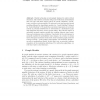Free Online Productivity Tools
i2Speak
i2Symbol
i2OCR
iTex2Img
iWeb2Print
iWeb2Shot
i2Type
iPdf2Split
iPdf2Merge
i2Bopomofo
i2Arabic
i2Style
i2Image
i2PDF
iLatex2Rtf
Sci2ools
SOFSEM
2007
Springer
2007
Springer
Games, Time, and Probability: Graph Models for System Design and Analysis
Digital technology is increasingly deployed in safety-critical situations. This calls for systematic design and verification methodologies that can cope with three major sources of system complexity: concurrency, real time, and uncertainty. We advocate a two-step process: formal modeling followed by algorithmic analysis (or, “model building” followed by “model checking”). We model the concurrent components of a reactive system as potential collaborators or adversaries in a multi-player game with temporal objectives, such as system safety. The real-time aspect of embedded systems requires models that combine discrete state transitions and continuous state evolutions. Uncertainty in the environment is naturally modeled by probabilistic state changes. As a result, we obtain three orthogonal extensions of the basic state-transition graph model for reactive systems —game graphs, timed graphs, and stochastic graphs— as well as combinations thereof. In this short text, we provide...
| Added | 09 Jun 2010 |
| Updated | 09 Jun 2010 |
| Type | Conference |
| Year | 2007 |
| Where | SOFSEM |
| Authors | Thomas A. Henzinger |
Comments (0)

